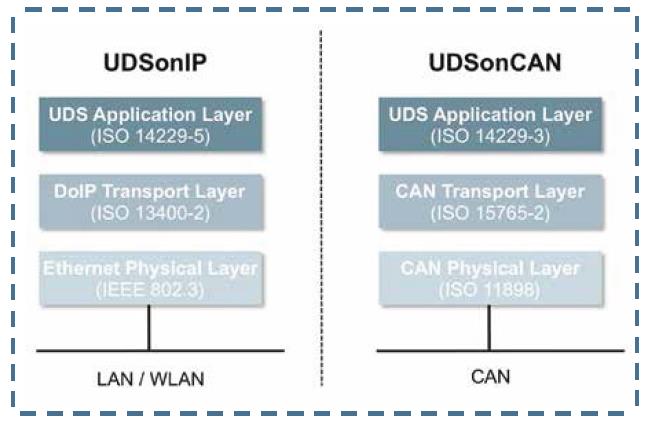What is Diagnostic over Internet Protocol (DoIP)?
As the name suggests, DoIP is the automotive diagnostics protocol based on IP. Defined by ISO 13400-2 standard, DoIP facilitates diagnostics related communication between external test equipments and automotive control units (ECU) using IP, TCP and UDP.
DoIP also supports communication between on-board and off-board diagnostic systems of a vehicle.
Because DoIP enables access to the vehicle electronic components (a.k.a Automotive ECU) through Internet, it becomes possible to fetch diagnostic data from vehicle remotely, without requiring physical access to the vehicle.
In simple words, DoIP stack serves as a gateway for all the next generation Remote Vehicle Diagnostics applications!
Since the standard Ethernet Physical layer is used as a transmission medium for DoIP, it is also known as Diagnostics over Ethernet.
Following are some of the advantages of Ethernet MAC layer of DoIP stack solution:
- Ethernet is a low-cost technology which allows high bandwidth for data communication.
- It is a flexible communication platform and can be easily integrated into existing
- It is light weighted, simple shielded structured cable.
Why UDS over Ethernet (as DoIP) for next generation automotive applications?
The ever growing complexity of electronic systems and need for large volume of data communication between vehicle networks, meant that automotive OEMs’and Suppliers felt the need for a more effective vehicle communication network like Ethernet.
Case in point: ECU re-programming, remote & on-board diagnostics are some examples of automotive applications that demand for faster data transfer rate.
As Ethernet physical layer doesn’t support bus like structure (like that in CAN), a switch is required for every network node. This ensures that Ethernet based DoIP supports rates of upto 100 mbps as compared to 500 kbps by CAN.
In the past, OEM’s provided diagnostic services over proprietary or KWP protocols. But the trend has shifted to more popular Unified Diagnostic Services (UDS) protocol that supports various BUS systems such as CAN, K-line, FlexRay and Ethernet.
Hence, UDS is now the most properly used standard for Diagnostic Protocol. DoIP transport layer is defined as a part of the UDS specification.
ISO-OSI Model of DoIP based software architecture
:
- As mentioned before, ISO 13400-2 transport layer facilitates diagnostic communication between external test equipment and vehicle electronic components.
- The implementation of a common set of Unified Diagnostic Services (UDS) on Internet Protocol (UDSonIP) is done using ISO 14229-5 Application layer.
- The Vehicle transport layer is facilitated by TCP or UDP. Based on the standard, IPv6 acts a Network Layer and IPv4 can be used for compatibility.
- Ethernet MAC is used as the Data Link Layer. The corresponding Physical Layer for on-board communication is specifies as Broad Reach or 100 Base T, while that for off-board communication is Ethernet.
Comparison between UDS on IP and UDS on CAN:.
Here is a comparison between UDS on IP and UDS on CAN, on the basis of system architecture and data transmission:
On the basis of systems architecture:
-
- UDS application layer has been modified to support compatibility with Ethernet transmission medium. This compatibility for UDS on IP is defined by ISO 14229-5 standard.
While the ISO 14229-3 standard defines implementation of UDS on CAN.
- UDS on IP has DoIP Transport Layer defined by ISO 13400-2 standard. While UDS on CAN has ISO 15765-2 transport layer that support CAN physical layer.
- The physical layer for UDS on IP is Ethernet, based on IEEE 802.3, a wired vehicle interface standard and the UDS on CAN is defined by ISO 11898 standard (classical CAN network).
On the basis of Data Transmission:
- UDS on IP supports greater latency time of data transmission as compared to CAN.
- A greater bandwidth capacity in DoIP enables it to handle large amount of data in comparison with CAN.
- The standardized data format in DoIP makes the data less prone to error and ideal for diagnostic services.
Important Features of ISO 13400-2:2012
ISO 13400-2:2012 defines the requirement for vehicle gateway (for an instance, for integration into an existing computer network) and requirements for the test equipment (for example, to detect and establish communication with vehicle).
ISO 13400-2 is a significant for diagnostic communication. Here are some of its important features:
- Vehicle network integration (IP address assignment).
- Vehicle announcement and vehicle discovery.
- Vehicle basic status information retrieval (example: diagnostic power mode).
- Connection establishment, connection maintenance and vehicle gateway control.
- Data routing to and from the vehicle’s sub components.
- Error handling (example: physical network disconnect).
The optional features of ISO 13400-2:2012 –
- DoIP entity status monitoring.
- DoIP entity firewall capabilities.
In simplest terms, remote vehicle diagnostics is a setup where the diagnostic tool (test equipment) and the vehicle ECU are separated by an internetwork, e.g., the Internet.
The importance of remote ECU diagnostics lies in its ability to streamline maintenance processes, reduce downtime, and improve overall vehicle performance.
Remote diagnostics is a feature that benefits both end users and the OEMs. For the vehicle owners, it provides the ease of diagnosing and fixing issues without visiting the service centre. And for the OEMs, remote ECU diagnostics enables proactive monitoring of vehicle performance, identifying potential issues, and pushing software updates over the air. All such actions result in improving fuel efficiency and addressing safety-related concerns.
Now that we have established the importance remote vehicle diagnostics, lets explore about the enabler of such important function.
The key to realizing an efficient remote vehicle diagnostic system is to establish standardized interfaces for communication. Diagnostics over Internet Protocol (DoIP) is the de facto standard that helps enable remote diagnostics for vehicle ECUs.




